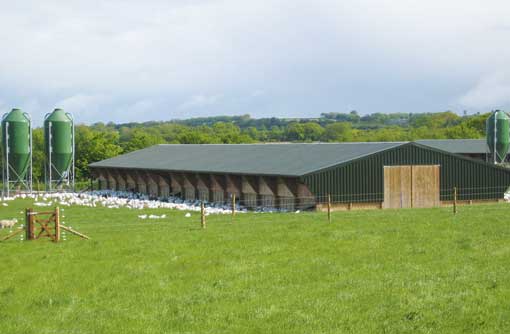Think like an objector when it comes to planning

Securing planning permission for poultry sheds is notoriously difficult. So how can you maximise your chances of success? Olivia Cooper reports
Getting planning permission for any farm building can be a long and drawn out process. But poultry sheds often incite more public objections than any other application, raising concerns about destruction of the rural landscape, pollution and pests.
However, by taking a considerate and sustainable approach, farmers can optimise their chances of success, and at the same time create a poultry unit that fits seamlessly into its surroundings.
Ivan Moss, senior planning adviser at the NFU, says the biggest mistake that farmers make is to decide what they want to build, and hope everyone else will agree. “You have to think like an objector and look at the weaknesses in your proposal.”
Initially, farmers should identify the best site, building design and size for their business, and then find any pitfalls that might generate objections. “Consult with parishioners and the planning authority at an early stage, to get your positive messages across before the opposition claims the high ground with myths and rumours.”
Becoming a local councillor can also be beneficial, adds Mr Moss. “Councils are often made up of incomers rather than local people, which can make them hard to persuade. Don’t assume they understand agriculture – you need to explain why the building needs to be a certain size, and why it’s designed and sited the way it is.”
Common concerns include access, noise, sight, smell and pests. “Look at how you can add value through landscaping, habitat creation or renewable energy production. And consider the prevailing wind and proximity to houses. Listen to peoples’ concerns and be prepared to compromise.
“In the good old days, submitting the planning application was the start of the process – now it’s almost the end of it,” he adds. The larger the project the more time it will take to plan – and the more consultants that will be required. “Up front fees can be expensive, but it’s better than getting carried away on a project that is fatally flawed.”
When choosing a site, farmers should consider proximity to utilities and suitability of access, adds landscape architect Nicholas Pearson. Drainage and waste disposal must comply with environmental legislation – and wildlife surveys may be required if protected species like bats or newts are present.
“Look at other units to get ideas about new products and designs, and consider future expansion plans from the start.” The proposed building will have to comply with local planning policies in terms of location, style and size, and should integrate as much as possible with the existing landscape.
“The best colours for integration are mid-range greens and browns, and opt for low-reflective roofing materials,” says Mr Pearson. “Think about energy efficiency and how the building will work in practice – and landscape the area with hedges and trees to put back more biodiversity than you’ve taken out.”
Case study: Les Heywood, Devon
Les Heywood keeps 23,000 free-range meat birds at Hollyfield Farm, Rackenford, Devon, and has erected four permanent sheds over the past seven years, with another on the way.
“We started out with a 17-acre field on the top of a hill, and applied for four 48m x 9.65m sheds, a 5kW wind turbine and a mobile home for us to live in,” he says. “The design was very important – the houses are 7ft to the eaves and although we’re pretty remote, we are overlooked by neighbours.”
Mr Haywood used timber frames and cladding, with dark green steel roofs to create a rustic look. “The sheds are spread across the field rather than all in one place, and we used green fibreglass feed silos rather than galvanised ones – it all blends in quite nicely.”
In addition, he landscaped the area with Devon banks, planted with 3,500 trees to create hedgerows. “We spoke to our neighbours and planners early, and it now all looks quite nice. In hindsight, the only thing we’d do differently is paint the mobile home green too.”
Conference details
The NFU and Nicholas Pearson will be among a number of high profile international speakers at the RIDBA Farm Building Design conference in Bath on 19 April. The conference will cover the impact of emerging agricultural policies and farm scale, the influence of building design on enterprise performance, as well as increasing landscape protection and planning considerations. For more information visit www.ridba.org.uk or call 01449 676 049.
